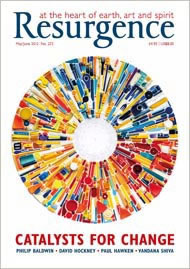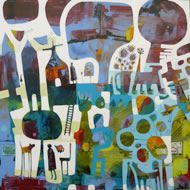The inspiration to re-imagine the purpose of museums was born out of the observations I made as director of the Museum of East Anglian Life (MEAL) in Stowmarket – a open-air museum with historic buildings and working collections in a beautiful natural environment.
My aim was to place MEAL within the rhythm of local life, whether it’s leading the Plough Sunday commemorations in the parish church in January, running a popular beer festival in June or hosting a bonfire party in November. The museum exists to encourage people to look at the world differently; and to help achieve this we’ve worked with dance companies and the London Sinfonietta, and for three years we have run a successful Gypsy arts festival.
MEAL runs a range of learning programmes, using its historic buildings, landscape and collections to inspire vulnerable people. This includes training and skills development for adults with learning disabilities and long-term unemployed people, a resettlement programme for inmates from a local prison, therapeutic placements for mental health service users, reminiscence training for carers of people with early-stage dementia, and training schemes for young people with behavioural problems.
It was soon clear that being engaged in these activities at the museum made participants happy. They formed new friendships. They ran each other to the shops and supported each other through personal problems; people who previously had led isolated lives had a new-found confidence to socialise. They began to trust one other; they had discovered a new sense of status and they became more adaptable. Far from being a refuge, the museum had become an amazing springboard for participants.
The programmes MEAL offered could have been carried out anywhere – on an industrial estate or in a forest park – but what made them special was the use of cultural heritage within a museum, which many were encountering for the first time. A Fordson tractor was restored by a group of young people who had left school with no qualifications, and a group of mental health service users are now running our Victorian Walled Garden. The success of the museum’s work is not measured by the queues out of the door for blockbusters, but by the strength of those new social networks created by a shared interest in identity and locality.
Building a resilient organisation based on relationships and bonds between individuals should be grist to the mill for museums. In his 13 volumes of studies of village life in East Anglia, George Ewart Evans, a pioneer of English oral history and co-founder of MEAL, showed that reciprocity was key to the functioning of an agricultural village right up until the Second World War: “The miller and the millwright, the harness-maker and the tailor show how the old village community was dovetailed together by the nature of the work.”
Drawing on the experience of exploring the nature of social capital at MEAL, I founded the Happy Museum Project. In March 2011 we published The Happy Museum: A Tale of How It Could Turn Out All Right, a paper co-written by the New Economics Foundation (nef) and leading museum commentators. It argues that museums have innate qualities that can inspire a re-imagining of a society that values cooperation and stewardship of our surroundings as much as it does economic wellbeing.
In her speech to the Museums Association conference in Brighton last year, Caroline Lucas, Britain’s first Green MP, quoted extensively from the paper, making the links between museums and sustainability. Museums should take advantage of the widespread sense of public trust they enjoy, their position as public spaces and their status as a sanctuary from commercial messages “with little to sell but understanding and enjoyment” (apart from the ubiquitous gift shop).
The paper concludes with a set of eight principles that provide a starting point for creative inquiry. They examine how museums might cement the linkage between wellbeing and environmental sustainability, how they might pursue more mutual relationships within civic society, and how they might better articulate the possibilities of a good life in a low-carbon world.
In order to test the Happy Museum proposition, we commissioned six museums to carry out projects that seek to better connect people and institutions with each other and their environment. They include London Transport Museum, which is working with St Mungo’s (a charity that supports homeless people) to create a Conversation Hub within the museum; Godalming Museum, which is connecting with a variety of civic society groups including Transition Godalming to explore the town’s hydro-electric heritage; and The Story Museum in Oxford, which is working with psychologists and wellbeing experts to influence designers and architects as they engineer their new capital developments.
At a recent Happy Museum symposium in Snape, Suffolk there were further provocations to museums to use their inherent qualities to re-imagine a future with a more resilient global and local community. Paul Allen from the Centre for Alternative Technology in Machynlleth noted that museums can tell “a realistic and joined-up story of how we have got to where we are today”. Their assembled knowledge and artefacts from mining to rural life hold the potential to really bring this story to life.
Andrew Simms from nef noted that museums with their collections spanning thousands of years of human history were well placed to debunk the “myth of permanence”. Museums are able to show how people have both adapted and rallied in the face of both sudden cataclysms and gradual trends.
Some UK museums have made a good start in this process. For example, M Shed in Bristol has developed permanent displays about greening the city, working with Transition groups and civic society groups.
Of course, many museums do appreciate their position at the heart of their community, and many already combine scholarship, stewardship, learning and a desire for greater participation. What the Happy Museum Project is trying to do is to show that the context is now different. Climate change, pressures on the planet’s finite resources, and awareness that a good, happy society need not set economic growth as its most meaningful measure offer a chance to re-imagine the purpose of museums.
Museums need to realise their role as connector, viewing people not as audiences but as collaborators, not as beneficiaries but as citizens and stewards who nurture and pass on knowledge to their friends and neighbours.







